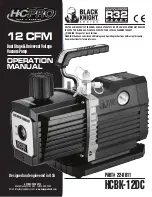
Installation
36
TT Twin-Screw Pump -
Installation, Operation & Maintenance Manual
negatively affect horizontal angular correction and may require re-performing the angular
alignment step.
Figure 9 Example of incorrect horizontal alignment (top view)
Perform complete alignment for a vertical correction
Refer to "
Allowable indicator values for alignment checks
" for the alignment values.
A unit is in complete alignment when both the angular alignment indicator and the parallel
alignment indicator do not vary by more than the table limits when measured at two points
180° apart at the operating temperature.
NOTICE:
The specified misalignment values are valid only at operating temperature. For cold settings,
different values must be used to account for the expected thermal expansion. Failure to do so
can result in being unable to successfully perform hot alignment.
1. Set the angular and parallel dial indicators to zero at the top-
center position (12 o’clock)
of the driver coupling half.
2. Rotate the indicators to the bottom-
center position (6 o’clock).
3. Record the indicator readings.
4. Make corrections according to the separate instructions for angular and parallel
alignment until you obtain the allowable reading values.
Perform complete alignment for a horizontal correction
A unit is in complete alignment when both the angular alignment indicator and the parallel
alignment indicator do not vary by more than the table limits when measured at two points
180° apart at the operating temperature.
1. Set the angular and parallel dial indicators to zero at the left side of the driver coupling
half, 90° from the top-
center position (9 o’clock).
2. Rotate the indicators through the top-center position to the right side, 180° from the start
position (3 o’clock).
3. Record the indicator readings.
















































